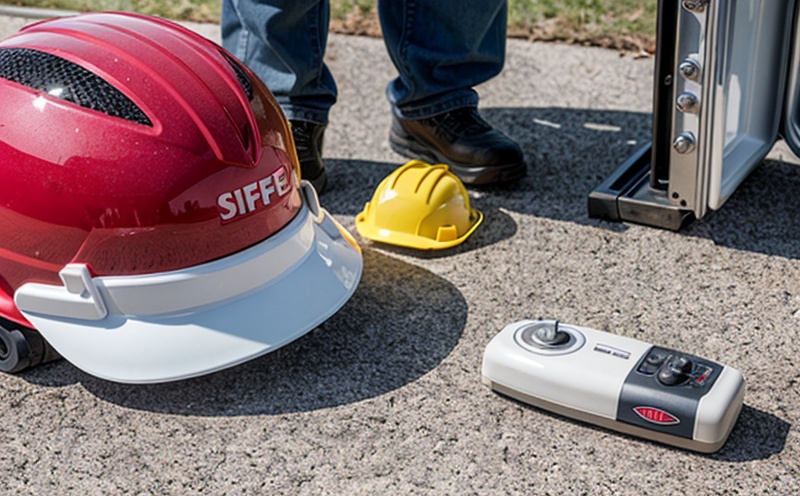ISO 18840 Smoke Signal Testing
The International Organization for Standardization (ISO) has established a suite of standards to ensure maritime safety and efficiency. One such standard, ISO 18840, specifically addresses the performance requirements and testing methods for smoke signals used in marine environments. Smoke signals are critical for emergency communications, especially during accidents at sea where visual contact is essential.
The primary objective of this test is to evaluate the performance characteristics of a smoke signal, ensuring it meets all specified criteria under various environmental conditions. This includes assessing the signal's visibility from different angles and distances, its ability to persist in the air for extended periods, and its overall reliability. Testing these parameters ensures that the equipment can function effectively during critical moments.
The ISO 18840 standard provides a comprehensive framework for conducting these tests. It outlines specific procedures for simulating real-world conditions under which smoke signals must perform optimally. This includes controlled environmental chambers designed to replicate wind speed, humidity levels, and atmospheric pressure typical of maritime settings.
For accurate testing, specimens undergo rigorous preparation processes that vary depending on the type of signal being tested. Typically, this involves ensuring the specimen is free from any defects or contamination before placing it in a test chamber. Once prepared, the smoke signal is exposed to standardized environmental conditions while being observed by trained personnel using calibrated instruments.
The results generated from these tests are meticulously documented and compared against predefined acceptance criteria laid out in ISO 18840. Compliance with these standards guarantees that each smoke signal meets international quality benchmarks, enhancing safety measures aboard ships and ensuring effective communication during emergencies.
By adhering to the strict guidelines set forth by ISO 18840, manufacturers can ensure their products meet stringent requirements for maritime applications. This not only bolsters confidence among end users but also supports regulatory compliance efforts globally.
| Air Temperature Range | Humidity Levels |
|---|---|
| -10°C to +45°C | 20% RH to 98% RH |
| Wind Speed | Visibility Angle |
|---|---|
| 1-7 m/s | 0°, 45°, 90°, and 135° relative to the horizon |
Applied Standards
The ISO 18840 Smoke Signal Testing standard incorporates several key elements that are crucial for ensuring reliable performance of smoke signals in marine environments. These include:
- Testing procedures for evaluating the visibility and persistence of smoke signals under various climatic conditions.
- Specification of environmental parameters such as temperature, humidity, wind speed, and atmospheric pressure required to simulate real-world scenarios accurately.
- Detailed guidelines on specimen preparation methods aimed at minimizing variability in test results.
The standard also emphasizes the importance of using appropriate instrumentation for measuring performance metrics like luminance intensity, persistence time, and visibility range. Compliance with these rigorous testing protocols guarantees consistent quality across different brands and models of smoke signals.
| Standard | Description |
|---|---|
| ISO 18840-1 | General requirements for smoke signal performance |
| ISO 18840-2 | Testing methods for smoke signals under controlled conditions |
| ISO 18840-3 | Evaluation criteria based on test results |
Why Choose This Test
The ISO 18840 Smoke Signal Testing is essential for several reasons, particularly in the context of marine and ship equipment testing. Firstly, it ensures that all safety equipment complies with international standards, thereby enhancing overall maritime safety. Secondly, by adhering to these stringent tests, manufacturers can gain a competitive edge by producing high-quality products that meet or exceed global expectations.
Moreover, compliance with ISO 18840 fosters trust among users who rely on this equipment during emergencies. For instance, sailors and crew members depend heavily on reliable smoke signals for signaling distress or coordinating rescue operations. Reliable performance under all conditions is paramount in such critical situations.
The testing process also promotes innovation within the industry by encouraging continuous improvement of existing technologies while exploring new possibilities. As technology advances, so too must our understanding of how best to apply it effectively towards improving safety standards.
Lastly, successful completion of these tests provides peace of mind for regulatory bodies overseeing maritime activities worldwide. Knowing that all necessary precautions have been taken helps foster better relationships between governments, organizations, and private entities involved in shipping industries.
Use Cases and Application Examples
The ISO 18840 Smoke Signal Testing finds practical applications across various maritime scenarios where visual communication plays a vital role. Some notable use cases include:
Distress signaling: During incidents like collisions or capsizing, smoke signals are used to alert nearby vessels or coastguard services.
Pilot boarding: When new pilots board ships, they often rely on visual cues provided by smoke signals for orientation and safe approach.
Search and Rescue Operations: In cases where individuals are stranded at sea, smoke signals help coordinate rescue efforts more efficiently.
Navigation Aid: Some navigational aids employ smoke signals to indicate hazardous areas or obstacles in the water.
In each of these instances, reliability and effectiveness are paramount. The ISO 18840 testing ensures that all equipment used meets these critical requirements.
| Situation | Smoke Signal Role |
|---|---|
| Distress signaling | To alert nearby vessels or authorities to the need for assistance. |
| Pilot boarding | To guide incoming pilots safely onto the vessel. |
| Search and Rescue Operations | To facilitate coordination between various rescue teams. |
| Navigation Aid | To mark dangerous areas or obstacles for safe passage. |
| Example | Description |
|---|---|
| Pilot boarding smoke signals | Aids in the safe and efficient boarding process, reducing risks associated with poor visibility or bad weather. |
| Rescue smoke signals | Used during search and rescue operations to direct attention towards stranded individuals or vessels. |





